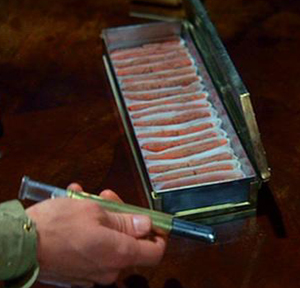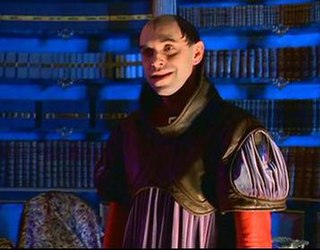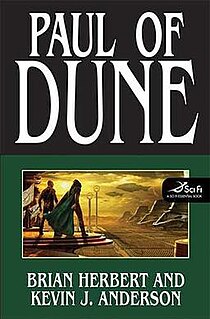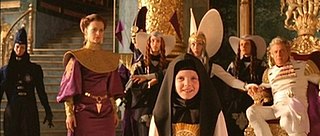
Paul Atreides is a fictional character in the Dune universe created by Frank Herbert. Paul is a prominent character in the first two novels in the series, Dune (1965) and Dune Messiah (1969), and returns in Children of Dune (1976). The character is brought back as two different gholas in the Brian Herbert/Kevin J. Anderson novels which conclude the original series, Hunters of Dune (2006) and Sandworms of Dune (2007), and appears in the prequels Paul of Dune (2008) and The Winds of Dune (2009).

Shaddam IV of House Corrino is a fictional character in the Dune universe created by Frank Herbert. He is Padishah Emperor of the Known Universe in Herbert's 1965 novel Dune. Shaddam's accession to the throne is chronicled in the Prelude to Dune prequel trilogy (1999-2001) by Brian Herbert and Kevin J. Anderson, and he later appears in the prequel series Heroes of Dune (2008–2009).

Melange, often referred to as simply "the spice", is the name of the fictional drug central to the Dune series of science fiction novels by Frank Herbert, and derivative works.

The Spacing Guild is an organization in Frank Herbert's science fiction Dune universe. With its monopoly on interstellar travel and banking, the power of the Guild is balanced against that of the Padishah Emperor as well as of the assembled noble Houses of the Landsraad. Mutated Guild Navigators use the spice drug melange to successfully navigate "folded space" and safely guide enormous heighliner starships from planet to planet instantaneously. Essentially apolitical, the Guild is primarily concerned with the flow of commerce and preservation of the economy that supports them; although their ability to dictate the terms of and fees for all transport gives them influence in the political arena, they do not pursue political goals beyond their economic ones. It is noted in Dune (1965) that Houses of the Imperium may contract with the Guild to be removed "to a place of safety outside the System"; in the past, some Houses in danger of ruin or defeat have "become renegade Houses, taking family atomics and shields and fleeing beyond the Imperium". The Guild controls a "sanctuary planet" known as Tupile intended for such "defeated Houses of the Imperium ... Location(s) known only to the Guild and maintained inviolate under the Guild Peace".

Arrakis —informally known as Dune and later called Rakis—is a fictional desert planet featured in the Dune series of novels by Frank Herbert. Herbert's first novel in the series, 1965's Dune, is popularly considered one of the greatest science fiction novels of all time, and it is sometimes cited as the best-selling science fiction novel in history.

Imperial House Corrino is a fictional noble family from the Dune universe created by Frank Herbert. The Corrinos come to power after humanity's victory against the thinking machines at the Battle of Corrin, and rule until deposed by Paul Atreides approximately 10,000 years later during the events of the novel Dune (1965).

A Guild Navigator is a fictional humanoid in the Dune universe created by Frank Herbert. In this series and its derivative works, starships called heighliners employ a scientific phenomenon known as the Holtzman effect to "fold space" and thereby travel great distances across the universe instantaneously. Humans mutated through the consumption of and exposure to massive amounts of the spice melange, Navigators are able to use a limited form of prescience to safely navigate interstellar space. Control of these Navigators gives the Spacing Guild its monopoly on interstellar travel and banking, making the organization a balance of power against the Padishah Emperor and the assembled noble Houses of the Landsraad.

A sandworm is a fictional creature that appears in the Dune novels written by Frank Herbert.

Ix is a fictional planet featured in the Dune series of science fiction novels written by Frank Herbert, and derivative works. In Dune (1965) it is noted that Ix is classed with the planet Richese as "supreme in machine culture," and that Ixian solido projectors "are commonly considered the best." In Dune Messiah (1969) Herbert explains that the planet's name is derived from the fact that it is the ninth planet of its sun. Ixian devices are commonplace and considered essential throughout the rest of the series, though they sometimes test the limits of the anti-technology proscriptions of the Butlerian Jihad, humanity's crusade against computers, thinking machines, and conscious robots.

Princess Irulan is a fictional character and member of House Corrino in the Dune universe created by Frank Herbert. She first appears in Dune (1965), and is later featured in Dune Messiah (1969) and Children of Dune (1976). The character's birth and early childhood are touched upon in the Prelude to Dune prequel trilogy (1999–2001) by Brian Herbert and Kevin J. Anderson, and she is a principal character in the Herbert/Anderson series Heroes of Dune (2008–2009). Irulan has also appeared in all film and television adaptations of Herbert's Dune works.

Count Hasimir Fenring is a fictional character in the Dune universe created by Frank Herbert. He is featured in the 1965 science fiction novel Dune by Frank Herbert, and is also a key character in the Prelude to Dune trilogy by Brian Herbert and Kevin J. Anderson. He later appears in the 2008 novel Paul of Dune.

Dune: House Atreides is a 1999 science fiction novel by Brian Herbert and Kevin J. Anderson, set in the fictional Dune universe created by Frank Herbert. It is the first book in the Prelude to Dune prequel trilogy, which takes place before the events of Frank Herbert's celebrated 1965 novel Dune. Bantam Books made a $3 million deal for the novels in 1997. The Prelude to Dune novels draw from notes left behind by Frank Herbert after his death.

Emperor: Battle for Dune is a Dune video game, released by Westwood Studios on June 12, 2001. It is based in Frank Herbert's science fiction Dune universe. It is the third real-time strategy game set in the Dune universe, following its predecessors, Dune II and Dune 2000. While Dune II was a totally distinct story to that of Dune, and Dune 2000 was a remake of Dune II, Emperor is a direct sequel to the previous games. In particular, it is a sequel to Dune 2000, carrying on from where it left off, with several of the characters and actors returning. Like Dune 2000 and many of the other Westwood games that came before it, Emperor features cut scenes filmed with live actors.
Norma Cenva is a fictional character from the Dune universe created by Frank Herbert. Mentioned briefly in Herbert's God Emperor of Dune (1981), she plays a large role in the Legends of Dune prequel trilogy (2002–2004) written by Brian Herbert and Kevin J. Anderson. The character reappears as the Oracle of Time in the Brian Herbert/Anderson novels Hunters of Dune (2006) and Sandworms of Dune (2007), which conclude the original series.
This is a list of terminology used in the fictional Dune universe created by Frank Herbert, the primary source being "Terminology of the Imperium", the glossary contained in the novel Dune (1965).

Paul of Dune is a 2008 science fiction novel written by Brian Herbert and Kevin J. Anderson, set in the Dune universe created by Frank Herbert. Released on September 16, 2008, it is the first book in the Heroes of Dune series and chronicles events between Frank Herbert's Dune (1965) and Dune Messiah (1969), as well as between Dune and its 2001 Brian Herbert/Kevin J. Anderson prequel, Dune: House Corrino.

Multiple organizations of the Dune universe dominate the political, religious, and social arena of the fictional setting of Frank Herbert's Dune series of science fiction novels, and derivative works. Set tens of thousands of years in the future, the saga chronicles a civilization which has banned computers but has also developed advanced technology and mental and physical abilities through physical training, eugenics and the use of the drug melange. Specialized groups of individuals have aligned themselves in organizations focusing on specific abilities, technology and goals. Herbert's concepts of human evolution and technology have been analyzed and deconstructed in at least one book, The Science of Dune (2008). His originating 1965 novel Dune is popularly considered one of the greatest science fiction novels of all time, and is frequently cited as the best-selling science fiction novel in history. Dune and its five sequels by Herbert explore the complex and multilayered interactions of politics, religion, ecology and technology, among other themes.














